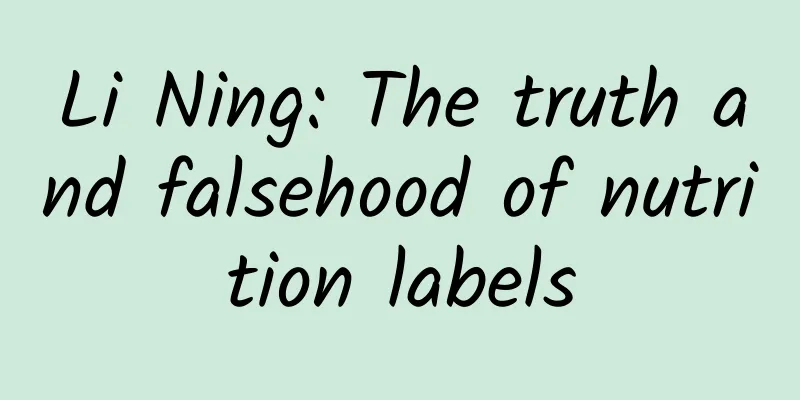Li Ning: The truth and falsehood of nutrition labels

|
Researcher Li Ning Vice President of Chinese Society of Food Science and Technology Director of National Food Safety Risk Assessment Center Expert opinion 1: The National Food Safety Standard General Rules for Nutrition Labeling of Prepackaged Foods is an important regulatory basis for labeling nutrition information Pre-packaged food manufacturers should label the nutritional information of their products based on the National Food Safety Standard - General Rules for Nutrition Labelling of Pre-packaged Foods (GB 28050-2011). The main contents of the standard include the nutrition table, nutrition claims and nutrition function claims. The Nutrition Facts Table is a standardized table that indicates the name, content and percentage of the Nutrient Reference Value (NRV) of food nutrients. It is mandatory to indicate the content, among which energy, protein, fat, carbohydrates and sodium must also be indicated in the Nutrition Facts Table. Nutritional claims are explanations of the content of nutrients, and there are regulations on when a nutrient is high, low, or free or rich. Nutritional function claims are descriptions of the physiological functions of nutrients, and both are voluntary. Expert opinion 2: Nutrition labeling should be truthful, objective and credible The value indicated on the nutrition label should truly and objectively reflect the content of nutrients in the product. Enterprises can obtain the content value of nutrients through product testing, or calculate it through product raw material formula. The allowable error between the indicated value and the measured value is an important basis for judging whether the indicated value on the label is accurate. According to the standard, the allowable error for protein, polyunsaturated and monounsaturated fats (acids), carbohydrates, vitamins (excluding vitamin A and vitamin D), minerals (excluding sodium), etc. is ≥80% of the indicated value; the allowable error for energy, fat, cholesterol, sodium, sugar (excluding lactose), etc. is ≤120% of the indicated value; the allowable error for vitamin A and vitamin D should be between 80% and 180% of the indicated value. Expert opinion 3: Nutritional claims and nutritional ingredient function claims must be clearly stated and supported by evidence Although nutrition claims and nutrition function claims are voluntary, they must comply with relevant regulations if they are required: 1. The corresponding nutrition content values must be listed in the nutrition table to give consumers a clear display; 2. Claims can only be made when the nutrition content meets the requirements or other restrictive conditions; 3. If claims are made, the claim terms used must strictly comply with the standard specification terms and cannot be changed at will. The standardization of nutrition claims and nutrition function claims avoids misleading consumers. Expert opinion 4: Continuously improving relevant standards is an important means to promote national health At present, the "National Food Safety Standard General Rules for Nutrition Labeling of Prepackaged Foods" (GB 28050-2011) is being revised. Taking into account the current prominent problems of national nutrition and health, it has added mandatory labeling requirements for nutrients such as sugar and saturated fatty acids. At the same time, companies are encouraged to use more understandable methods such as graphics and text in voluntary labeling to supplement the information on the nutrition table, so that consumers can understand the nutritional characteristics of food more intuitively. Through the continuous revision and improvement of standards, food companies are encouraged to standardize their labeling, and it is also convenient for consumers to understand nutrition labels, so that they can rationally choose foods and match meals, and continuously improve their own nutritional health levels. Picture丨TuChong Creative Expert suggestion 1: Companies should correctly adopt the method of determining the labeled value and scientifically prepare nutrition labels Determining the nutrition label value should be the most cautious step for companies to make nutrition labels. If the nutrient content value is obtained through product testing, the company should determine the source, batch and quantity of the sample for random inspection based on the characteristics of the product or nutrient, and give priority to the testing method specified in the national standard. In principle, it should be able to reflect different batches of products to ensure the reliability of the labeled data. For foods with unstable nutrient content or easily changing raw material background values, the number of testing batches should be increased accordingly. If the value is calculated based on the product raw material formula, the enterprise should use reliable data, such as the test data provided by the supplier, the data accumulated in the production and research and development of the enterprise's products, or the database published by the authoritative organization, etc. In order to ensure the traceability of the value, it is recommended that the enterprise retain the relevant information so as to query and correct related problems in a timely manner. Expert advice 2: Choose food scientifically based on your own nutritional and health needs Consumers are advised to learn to read and understand labels. For people who need to consume more certain nutrients, such as children and adolescents who are in the growth and development period, the demand for protein is relatively strong. When choosing food, they can appropriately choose foods with higher protein content. For consumers who need to limit some nutrients, such as patients with hypertension, they can choose foods with low sodium content. The percentage of NRV of the nutrient content in the nutrition information table can also be used to guide the proper diet. For example, if the NRV% of protein in a food is 6% per 100g, it means that the protein intake of 100g of the food only meets 6% of the daily protein requirement, and other foods are needed to supplement the protein intake. The "Scientific Interpretation of Food Safety and Health Hot Topics Media Communication Conference" has been held for 10 consecutive years since 2012. Every year, authoritative experts are invited to provide scientific interpretations of the annual food safety and health hot topics. In the form of "consensus in the scientific and technological community", it is widely disseminated through mainstream media and new media, such as television, newspapers, the Internet, Weibo, WeChat, etc. With scientific truth and fair suggestions, we will guide the public opinion on food safety in my country to gradually change in a scientific, objective and rigorous direction, and convey the positive energy of China's food safety. |
<<: Luo Yunbo: Near-expiry food is hotly debated, the market is hot but don’t let it go bad
>>: Liu Xiumei: How to rationally view the excessive indicator bacteria?
Recommend
Brown discharge still present 22 days after medical abortion
Brown discharge still present 22 days after medic...
Is it effective to lose weight during menstruation?
There are so many different ways to lose weight. ...
If the fetus stops once, is it likely to stop next time?
Many pregnant women are very worried about fetal ...
Why can't you eat mango when you have your period?
Mango is rich in fiber. Some people think that ma...
Dietary recommendations for improving immunity for the elderly and patients with chronic diseases
Dietary recommendations for improving immunity fo...
Pregnancy test strips
Pregnancy is a very pleasant thing for a family. ...
What causes ectopic pregnancy?
When facing the problem of ectopic pregnancy, no ...
Can I eat barbecue when I have my period?
Many nutritionists call fried and grilled food wa...
After washing your hair, is it better to let it air dry or blow dry? Most people do it wrong
After washing our hair, we often face a very diff...
Can you really eat donkey-hide gelatin cake after abortion?
Women must pay more attention to taking care of t...
Clinical manifestations of vulvar schwannoma
Some of you may have heard of vulvar neurothelia,...
What to do if pregnant women have gastrointestinal colic
After a woman becomes pregnant, she will often ex...
What does an anechoic ovarian cyst mean?
Ovaries are important organs of women. Ovarian cy...
Pale lips during early pregnancy
In the early stages of pregnancy, if a woman'...
Female buttocks and thighs are cold
In daily life, some women often have cold buttock...









